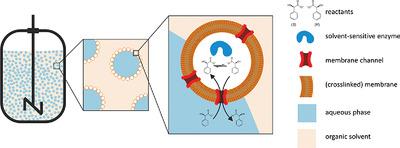当前位置:
X-MOL 学术
›
Biotechnol. J.
›
论文详情
Our official English website, www.x-mol.net, welcomes your
feedback! (Note: you will need to create a separate account there.)
Polymersomes as Nanoreactors Enabling the Application of Solvent-Sensitive Enzymes in Different Biphasic Reaction Setups.
Biotechnology Journal ( IF 3.2 ) Pub Date : 2020-07-22 , DOI: 10.1002/biot.201900561 Florian Golombek 1 , Kathrin Castiglione 1
Biotechnology Journal ( IF 3.2 ) Pub Date : 2020-07-22 , DOI: 10.1002/biot.201900561 Florian Golombek 1 , Kathrin Castiglione 1
Affiliation

|
There is an increasing interest in biocatalysis to perform chemical reactions in biphasic systems, consisting of an aqueous phase and a water‐immiscible organic solvent or ionic liquid. In most cases, the hydrophobic phase is used as reservoir for poorly water‐soluble substrates or for in situ product removal. However, many enzymes are solvent‐sensitive and cannot be used in such systems. In this study, the solvent‐sensitive enzyme mandelate racemase is exemplarily protected from the organic phase by its entrapment in (crosslinked) polymersomes. The covalent crosslinking of the individual chains of the block copolymer poly(2‐methyloxazoline)15‐poly(dimethylsiloxane)68‐poly(2‐methyloxazoline)15 via terminal methacrylates leads to enhanced membrane stability. This effect is especially pronounced for long‐time incubation in the presence of organic solvents and ionic liquids. By using a gentle polymerization initiator at its minimal necessary concentration, the prior encapsulated enzymes remain intact during crosslinking. Although the insertion of natural channel proteins into the membrane improves the mass transport into the vesicles, it is non‐essential. Mandelate racemase in (crosslinked) polymersomes remains active in different highly dispersed biphasic systems for more than 24 h. The free enzyme, on the other hand, gets completely inactivated within 1 h, thus illustrating the potential of polymersomes as nanoreactors in biphasic reaction setups.
中文翻译:

Polymersomes作为纳米反应器,可在不同的双相反应设置中应用溶剂敏感酶。
在生物催化中进行双相反应的兴趣与日俱增,双相系统由水相和与水不混溶的有机溶剂或离子液体组成。在大多数情况下,疏水相用作水溶性差的底物或原位产品去除的储存库。但是,许多酶对溶剂敏感,因此无法在此类系统中使用。在这项研究中,对溶剂敏感的扁桃酸酯消旋酶可以通过截留在(交联的)聚合物囊泡中而免受有机相的影响。共价嵌段共聚物聚(2-甲基恶唑啉)的各个链的交联15 -聚(二甲基硅氧烷)68 -聚(2-甲基恶唑啉)15通过末端甲基丙烯酸酯导致增强的膜稳定性。在有机溶剂和离子液体存在下长时间孵育时,这种效果尤为明显。通过以最小的必需浓度使用温和的聚合引发剂,先前包封的酶在交联期间保持完整。尽管将天然通道蛋白插入膜中可改善进入囊泡的质量传输,但这不是必需的。(交联的)聚合物小体中的扁桃酸酯消旋酶在不同的高度分散的双相系统中保持活性超过24小时。另一方面,游离酶在1小时内被完全灭活,因此说明了聚合物囊泡在双相反应设置中作为纳米反应器的潜力。
更新日期:2020-07-22
中文翻译:

Polymersomes作为纳米反应器,可在不同的双相反应设置中应用溶剂敏感酶。
在生物催化中进行双相反应的兴趣与日俱增,双相系统由水相和与水不混溶的有机溶剂或离子液体组成。在大多数情况下,疏水相用作水溶性差的底物或原位产品去除的储存库。但是,许多酶对溶剂敏感,因此无法在此类系统中使用。在这项研究中,对溶剂敏感的扁桃酸酯消旋酶可以通过截留在(交联的)聚合物囊泡中而免受有机相的影响。共价嵌段共聚物聚(2-甲基恶唑啉)的各个链的交联15 -聚(二甲基硅氧烷)68 -聚(2-甲基恶唑啉)15通过末端甲基丙烯酸酯导致增强的膜稳定性。在有机溶剂和离子液体存在下长时间孵育时,这种效果尤为明显。通过以最小的必需浓度使用温和的聚合引发剂,先前包封的酶在交联期间保持完整。尽管将天然通道蛋白插入膜中可改善进入囊泡的质量传输,但这不是必需的。(交联的)聚合物小体中的扁桃酸酯消旋酶在不同的高度分散的双相系统中保持活性超过24小时。另一方面,游离酶在1小时内被完全灭活,因此说明了聚合物囊泡在双相反应设置中作为纳米反应器的潜力。











































 京公网安备 11010802027423号
京公网安备 11010802027423号